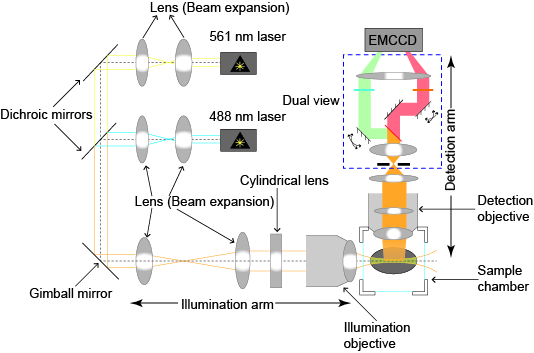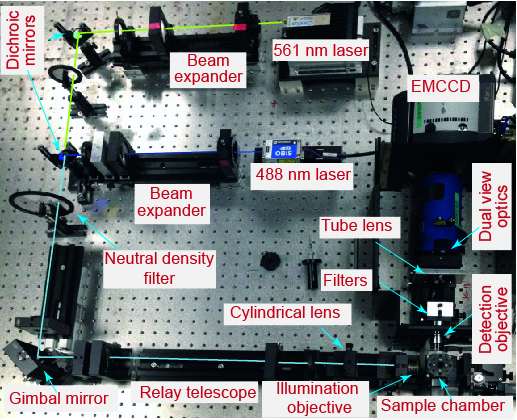SPIM-FCS
Imaging FCS has multiplexing capabilities attributed to the availability of light sheet based illumination schemes such as single plane illumination microscopy (SPIM). It provides intrinsic z-sectioning of the sample, in combination with the use of array detectors (EMCCD/sCMOS cameras) whose dimension of a single pixel provides the xy sectioning of individual observation volume (SPIM-FCS). Such a multiplexed system allows for simultaneous recording of multiple autocorrelation functions (ACFs) in each pixel over a large region of interest. This enables direct measurements of concerted dynamics over large spatial scales in live samples as opposed to single point measurements conducted in conventional FCS instruments.
Our current SPIM-FCS set up is a home built system which consists of two excitation laser lines (488 nm and 561 nm) along with a cylindrical lens and a low NA illumination objective, SLMPlan N (20×/0.25) (Olympus Singapore). For the detection pathway, we mounted a high NA water-immersion objective, LUMPlanFL N (60×/1.0) (Olympus Singapore) directly to the sample chamber and conducted FC(C)S measurements with an electron multiplying charge-coupled device (EMCCD) camera (Andor iXon 860) mounted after a dual view compartment located in between the detection objective and the EMCCD camera.


References:
Singh, A.P.; Krieger, J.W.; Buchholz, J.; Charbon, E.; Langowski, J.; Wohland, T. The performance of 2D array detectors for light sheet based fluorescence correlation spectroscopy, Optics Express, 21(7) (2013) 8652-8668.
Ph. D thesis: Anand Pratap Singh: Light sheet based fluorescence correlation and cross-correlation spectroscopy for quantitative measurements of bio-molecules in live cells
Sezgin E, Azbazdar Y, Ng XW, Teh C, Simons K, Weidinger G, Wohland T, Eggeling C, Ozhan G. Binding of canonical Wnt ligands to their receptor complexes occurs in ordered plasma membrane environments. FEBS J. 2017 Jun 19.
Ng XW, Teh C, Korzh V, Wohland T. The secreted signaling protein wnt3 is associated with membrane domains in vivo: a SPIM-FCS study. Biophys J. 2016 Jul 26;111(2):418-29.

